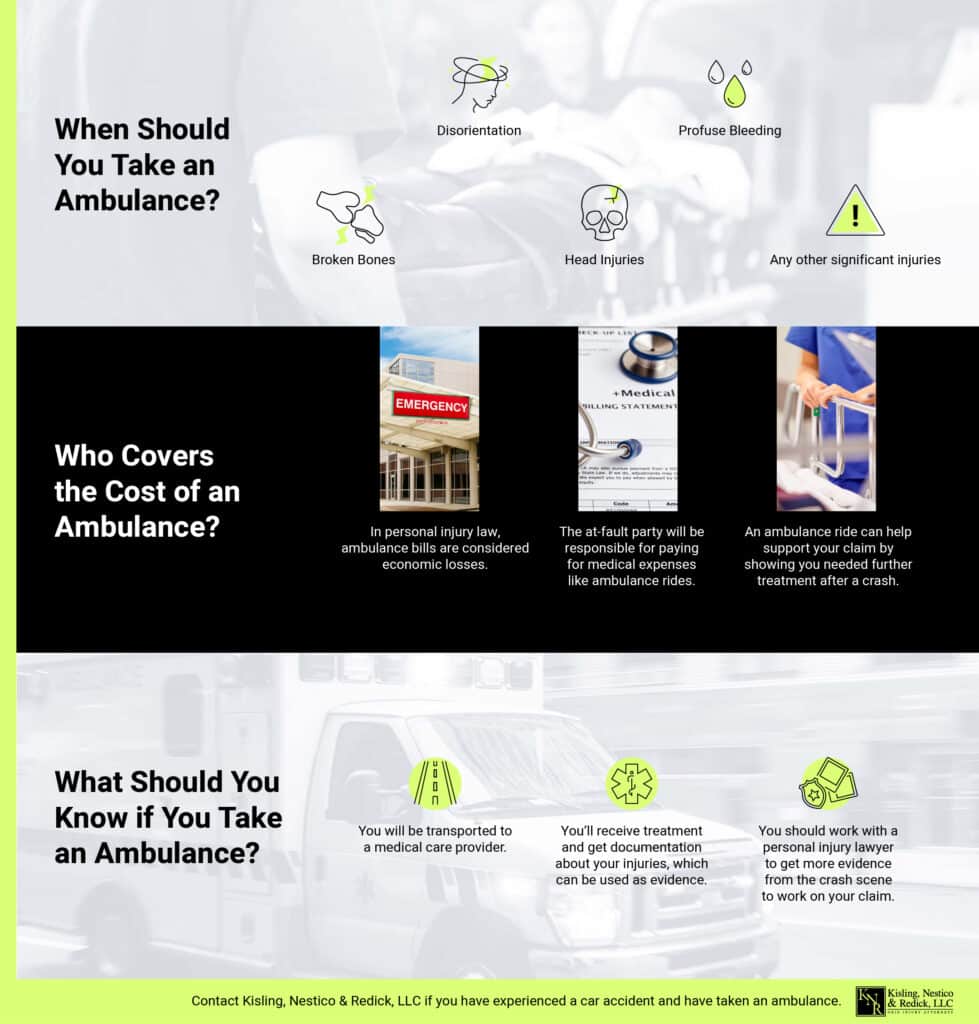Filing a Car Accident Claim in Cuyahoga County: What Makes Cleveland Different
Posted in: Car Accidents

The average cost of an ambulance ride rose 22% between 2017 and 2020 to $1,277.
Car crashes are traumatic. You’ll likely have medical costs and property damage to cover, and dealing with an ambulance bill might seem like too much. But if another driver’s negligent behavior caused the crash that injured you, you could recover the expenses needed to pay for your ambulance ride, a ride that could save you trouble in the long run.
Kisling, Nestico & Redick are ready to hear your case after you’ve been injured in an Ohio car crash. Our car accident attorneys have been helping clients in similar cases get compensation for years. Get started with a free consultation. Call 1-800-HURT-NOW.

It’s not common knowledge, but refusing a ride to a hospital or treatment center is an option after a car crash. Whether that’s the right call is up to you, but it’s easy to get confused in the aftermath of a collision.
There are many things to take care of: answering questions from responding law enforcement, getting evidence from the scene, taking care of any loved ones or pets in your car, and being examined by paramedics.
You’ll have to decide whether to ride in the ambulance. There could be instances where you might not have a choice, like if knocked unconscious. But how do you decide if you need the ride?
Paramedics and Emergency Medical Technicians can guide your decision to ride in an ambulance, but the severity of your injuries will play a big part.
Life-threatening injuries are usually significant factors in emergency transportation to a hospital or emergency room. Examples of serious injuries include:
When paramedics arrive at a crash, they look at how many people were injured in the crash, check their conditions, then decide how to treat them.
They’ve been trained to know when someone needs emergency care. When they evaluate, they can determine if there are any “invisible” injuries or if you’d get a more accurate evaluation at an emergency room.
Sometimes the damage after a car accident can take a while to manifest. You might initially feel slight discomfort and refuse an evaluation, but those injuries could become apparent in the days and weeks after the crash.
Your insurance claim could be weakened if you don’t get your injuries diagnosed and treated. Some invisible injuries include:
Some of these are soft tissue injuries and could be challenging to diagnose without specialized equipment. Their symptoms become obvious after a few days, and you could suffer extensive damage before you realize it.
If you choose not to receive an evaluation or a ride to the hospital from the scene of a crash someone else caused, still seek medical treatment. You need to identify your injuries, get them treated, and work on improving your health quickly. Waiting too long to get treatment can hurt your claim.
Insurance companies look to avoid payouts as much as possible. If you don’t identify your injuries or seek treatment as soon as possible, an insurance company could use that to argue your case isn’t that urgent. They might say the crash didn’t cause your injuries. They could also argue that your injuries aren’t that severe.
Although ambulance bills can be expensive, insurance policies should cover them. The driver responsible for causing the crash should be the one to pay for that expense.
That’s why working with a car accident lawyer who understands Ohio’s laws will be able to provide you with a fighting chance at recovering financially. Your attorney can help you identify the at-fault party so you aren’t on the hook for a necessary expense like an ambulance ride.
In Ohio, you can pursue economic and non-economic damages. These are expenses caused by the car crash. Non-economic damages are conceptual in nature, items that are difficult to assign a dollar amount. Mental anguish or pain and suffering might not have an exact cost, but they’re still expenses the at-fault party should pay for after a crash.
Economic damages are documented expenses. These include medical bills, prescriptions, treatments, property repairs or replacements, or lost wages.
A ride to an ambulance will be included in your total losses as economic damage.
After a car accident, the sooner you can get evaluated and treated, the better. Not only is this good for your overall well-being, but it can bolster your insurance claim. That doesn’t mean you have to ride in an ambulance to win your lawsuit.
Paramedics can evaluate you at the scene. If they believe you need more advanced medical care, they can recommend you go to the hospital or emergency room. You’ll be transported automatically if you’re unconscious or unresponsive after a car crash.
During an insurance claim, adjusters will be looking to see if you took reasonable steps to get treatment and if the crash caused your injuries. Paramedics’ statements and reports will be included in that investigation. If they recommend you take an ambulance, and you do, that can help your case. If they recommended and you refused, that opens the door to a defense against a payout.
If your injuries aren’t severe and the paramedics clear you to get treatment without an ambulance trip, you should still have a strong case if you go for evaluation as soon as possible.
After a car crash, it’s essential to act quickly and calmly. Time is of the essence, and getting assistance as soon as you can saves you time in the future in any lawsuit or claim you pursue.
First, you’ll need to ensure everyone in the car is okay. Some crashes can result in severe injuries or damage to the car. Get out if you can.
Next, you’ll need to call emergency services to the scene. Someone else will likely have already made a 911 call, but you can’t assume that. Provide the dispatcher with details about the crash: how many vehicles, people injured, and where the crash is.
Get photos or videos of the scene to help law enforcement and your insurance company understand what happened. Document the damage to vehicles, any injuries you have, and the road conditions. Look for traffic signs and record weather conditions.
Wait for emergency services to arrive and stay at the crash scene until you’ve been released. Provide the police and other drivers with your insurance contact information. You’ll also need to collect the other drivers’ info for your claim. Talk to the police about getting a report.
If you aren’t taking an ambulance for medical treatment, make arrangements to get evaluated and treated. You need to know how badly you’re hurt so you can work on an insurance claim.
Finally, contact an Ohio personal injury lawyer. An attorney can help you file a claim, negotiate a settlement, or take your case to trial if necessary. A knowledgeable attorney knows Ohio’s personal injury laws and can help you investigate your case, calculate damages, and work with insurance companies to pursue maximum compensation.
The car crash attorneys with Kisling, Nestico & Redick are prepared to hear your case. We understand how devastating car crashes can be, and we’ve helped clients like you recover millions of dollars over the years.
We know insurance companies are looking for any reason to lower your settlement. They need to make profits; paying out claims does not help their bottom lines. We can work with you to build the best case possible to secure the compensation you deserve.
Call 1-800-HURT-NOW or use our online form to schedule your free consultation.
View all Car Accidents resources